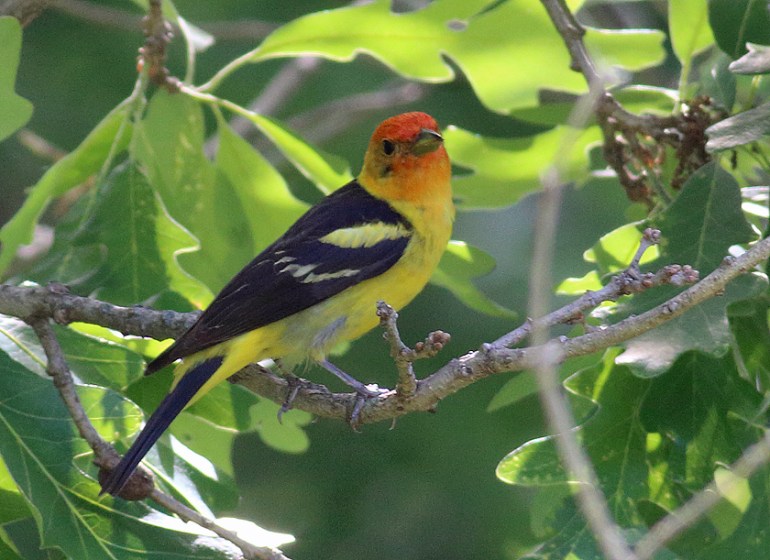Such a busy social calendar. Dress up in your summer finest. Find a home, try to settle down, find a good woman, chase her around incessantly, defend your territory against all comers…it’s a busy life for a bird in the spring. Two things that probably don’t help: 1) Being hopelessly lost and being the only one of your kind for a few hundred miles, and 2) being constantly interrupted by those pesky humans with the binoculars, cameras, and cell phones.
A male Western Tanager was found near Sioux Falls a couple of days ago. The closest Western Tanager should be 300+ miles to the west, in the Black Hills, so his appearance in eastern South Dakota caused a stir among the birding community. Heck, I too went to find him, as I haven’t seen a Western Tanager in South Dakota, outside of the Hills. But after twice going to watch him, I was starting to feel a bit sorry for him. He’s getting a lot of attention and visitors. His daily routine is also getting interrupted a lot.
I don’t mind birders using electronic calls to see a bird, but it does bother me when it’s done incessantly and it’s clearly affecting a bird. When I’m trying to take photos, I rarely use any electronic call, as not only do I not like the impact on the bird, I don’t like the unnatural look of photos of pissed off birds trying to figure out where that invisible “rival” is, and why he’s singing so much. The first time I went yesterday, there was a young, 14-year old birder walking up looking for the bird. I did pull out my phone, played about 5 seconds of a call, and the Tanager made an appearance for us. We then watched him for a while as he flew around the forest clearing, chasing a female Scarlet Tanager, chasing other birds out of his territory, and doing a lot of “fly-catching” (flying out from a perch to grab insects).
I thought I’d try again later in the day to try to get a better photo. He was reliably stationed in one location, and with patience, I was sure I’d get better photos than I got earlier in the day. However, as I walked into the clearing, there were 3 birders, a couple, and another older gentleman. I heard them all before I saw them. Or should I say, I heard the electronic calls they were playing over…and over…and over…and over again.
I left, rather than watch the poor confused Tanager desperately trying to find and dispatch his unseen “rival”. That was just one moment of the 2nd day after he was “found”. I have no doubt there were many occasions over the last few days where birders have come into the area with electronic calls, trying to get the perfect photo of an eastern South Dakota rarity. I probably could have gotten closer photos of a pissed off Western Tanager had I joined them in the clearing. And heck, 10 years ago, I might have joined them.. But as I’ve gotten older, I find myself using my binoculars far more than my camera. I used to only worry about getting that great photo, to the point that if I saw a bird but didn’t get a good photo, I was disappointed. Now I often find myself putting the camera down and just sitting and watching. The electronic call wasn’t necessary to enjoy watching this beautiful, lost Western Tanager.
Western Tanagers aren’t going extinct because of birders. Overall, the actions of birders with electronic calls aren’t likely to dramatically impact a species. But I still can’t help but feel a bit sorry for this one lost bird.

Photo of the Western Tanager near Sioux Falls. This was taken as he was flying from perch to perch, looking for insects and doing some “flycatching”. Not the greatest pic in the world, but I didn’t want to do what it would take to get that perfect Western Tanager photo.
Like this:
Like Loading...















































